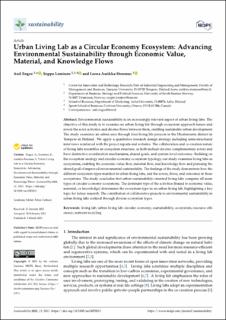| dc.contributor.author | Engez, Anil | |
| dc.contributor.author | Leminen, Seppo | |
| dc.contributor.author | Aarikka-Stenroos, Leena | |
| dc.date.accessioned | 2022-04-01T09:24:22Z | |
| dc.date.available | 2022-04-01T09:24:22Z | |
| dc.date.created | 2021-08-02T14:26:52Z | |
| dc.date.issued | 2021 | |
| dc.identifier.citation | Engez, A., Leminen, S. & Aarikka-Stenroos, L. (2021). Urban Living Lab as a Circular Economy Ecosystem: Advancing Environmental Sustainability through Economic Value, Material, and Knowledge Flows. Sustainability, 13(5), Artikkel 2811. | en_US |
| dc.identifier.issn | 2071-1050 | |
| dc.identifier.uri | https://hdl.handle.net/11250/2989175 | |
| dc.description.abstract | Environmental sustainability is an increasingly relevant aspect of urban living labs. The objective of this study is to examine an urban living lab through ecosystem approach lenses and reveal the actor activities and diverse flows between them, enabling sustainable urban development. The study examines an urban area through four living lab projects in the Hiedanranta district in Tampere in Finland. We apply a qualitative research design strategy including semi-structured interviews reinforced with the project reports and websites. The collaboration and co-creation nature of living labs resembles an ecosystem structure, as both include diverse complementary actors and have distinctive coordination mechanisms, shared goals, and system-level outcomes. Building on the ecosystem analogy and circular economy ecosystem typology, our study examines living labs as ecosystems, enabling the economic value flow, material flow, and knowledge flow and pursuing the shared goal of improved environmental sustainability. The findings of the study demonstrate how the different ecosystem types manifest in urban living labs, and the actors, flows, and outcomes in these ecosystems. The study concludes that urban sustainability-oriented living labs comprise all main types of circular economy ecosystems. The dominant type of the activities (biased to economic value, material, or knowledge) determines the ecosystem type in an urban living lab, highlighting a key topic for future research: The contribution of collaborative projects to environmental sustainability in urban living labs realized through diverse ecosystem types. | en_US |
| dc.language.iso | eng | en_US |
| dc.rights | Navngivelse 4.0 Internasjonal | * |
| dc.rights.uri | http://creativecommons.org/licenses/by/4.0/deed.no | * |
| dc.title | Urban Living Lab as a Circular Economy Ecosystem: Advancing Environmental Sustainability through Economic Value, Material, and Knowledge Flows | en_US |
| dc.type | Journal article | en_US |
| dc.type | Peer reviewed | en_US |
| dc.description.version | publishedVersion | en_US |
| dc.rights.holder | © 2021 by the authors. | en_US |
| dc.source.volume | 13 | en_US |
| dc.source.journal | Sustainability | en_US |
| dc.source.issue | 5 | en_US |
| dc.identifier.doi | https://doi.org/10.3390/su13052811 | |
| dc.identifier.cristin | 1923463 | |
| dc.source.articlenumber | 2811 | en_US |
| cristin.ispublished | true | |
| cristin.fulltext | original | |
| cristin.qualitycode | 1 | |

